Exploring Northern Spain & Basque Country
This post may contain affiliate links to products or services I'm happy to recommend. If you click on an affiliate link and then make a purchase, Artsy Traveler may earn a small commission at no cost to you. Thank you!
Northern Spain stretches from the Atlantic to the Pyrenees, a distance of almost 700 kilometers. This area of Spain boasts extraordinary scenery and something else you won’t see much of in the rest of Spain: rain.
Galicia in the northwest corner of Spain is green and gorgeous, with a culture that owes more to its Celtic neighbors in Brittany and Cornwall than to the rest of Iberia.
You’ll find a lot to enjoy in northern Spain—historic Santiago de Compostela, the Picos de Europa mountains, pinchos (pintxos) in San Sebastian, and the Guggenheim Bilbao, one of Europe’s top modern art museums.
Devote at least a week to this area of Spain. To help you plan your tour of northern Spain, I’ve compiled a ten-day itinerary that starts in Santiago de Compostela and ends in San Sebastian.
Getting Around
My itinerary presumes you’re driving. It’s possible to visit this area by train, but if you rent a car you can explore more of this fascinating and beautiful region, particularly the Picos de Europa.
Consider flying to Santiago de Compostela and touring the city for a few days before picking up your car and heading east. Drop it off in Bilbao and take a train to San Sebastian, or drive all the way to France and drop the car off there. Bordeaux is a convenient choice.
I suggest spending two days and three nights in Santiago de Compostela, one night on the north coast, three nights in or near Llanes to explore the Picos de Europa, one night in Santillana del Mar, one night in Bilbao, and one night in San Sebastian.
That’s a lot of one-night stands, so if you prefer and have the time, add more two-night stays. There’s a great deal to see in northern Spain!
Days 1 to 3: Santiago de Compostela
We spent a week in Santiago de Compostela a few years ago when Gregg had a major exhibition at the Granell Museum. The city of 100,000 people is a compact and lovely place with wonderful restaurants and parks and an atmospheric old town.
One of my favorite things to do was hanging out in the Praza do Obradoiro in front of the cathedral to watch Camino pilgrims enter the plaza. Santiago de Compostela, while not the actual end of the Camino de Santiago, is commonly the place most pilgrims stop.
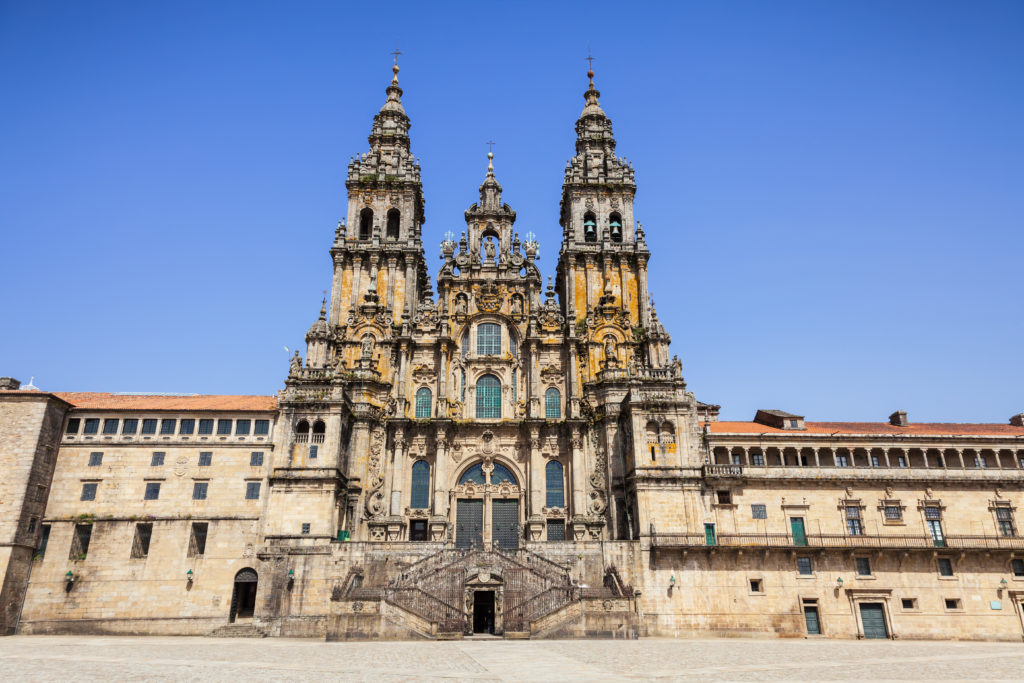
It was moving to see the pilgrims enter the plaza. Some were limping after weeks on the road, and most carried their pilgrim’s staff topped with a distinctive scallop shell similar to the shells that mark the Camino route. I saw a lot of tears and hugs and selfies.
Catedral de Santiago de Compostela
Pilgrims crowd into the cathedral where the remains of Saint James are allegedly buried. The cathedral is a jumble of architectural styles— Romanesque, Gothic, and Baroque. A highlight inside the west entrance is the Pórtico de la Gloria, containing 200 Romanesque sculptures dating from the late 12th century.
Truth be told, I found the cathedral dark and overcrowded, but there’s no denying the atmosphere of piety, particularly from the pilgrims who walked the Camino for religious reasons.
The Old Town
Wander the granite streets of the old town of Santiago, enjoying the arches, squares, and monuments that contributed to the city’s designation as a UNESCO World Heritage Site in 1985. You’ll find plenty of good shopping, particularly for jewelry. The atmosphere is laid-back and friendly, with throngs of students, pilgrims, tourists, and locals.
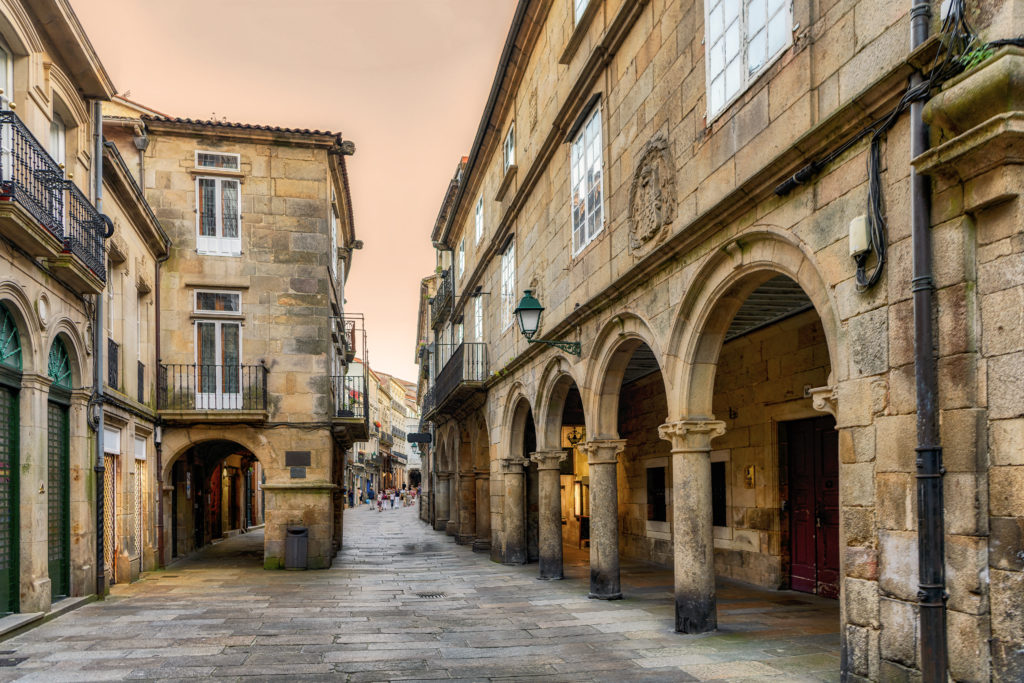
Parks and Museums
Alameda Park is a large green space, wonderful to chill out in away from the crowds in the Praza do Obradoiro. You also get a marvelous view of the cathedral from the park.
When Gregg was in Santiago on a solo trip, he came across a large group of people in traditional costumes playing instruments and dancing in San Domingos de Bonaval Park. Watch his video on YouTube. Notice how Celtic the music sounds with the drums and bagpipes—completely different from the flamenco rhythms in the south.
In Bonaval, you’ll also find the Galician Contemporary Art Centre and the Museum of the Galician People (Museo de Pobo Galego).
In Santiago de Compostela, you’ll notice that you’re in Galicia first, Spain second. Local people speak Galician and are proud of their heritage. You’ll be understood in Spanish, and likely in English, in restaurants and hotels.
On the Pazo de Bendaña, not far from the cathedral, is the Granell Museum, housed in a beautiful old Baroque building. If you’re a fan of Surrealism, check out this museum that includes an extensive collection of work by Eugenio Granell and other artists linked to Surrealism, including Marcel Duchamp, Max Ernst, Joan Miró, and Roberto Matta.
Dining in Santiago de Compostela
With so many students, tourists and pilgrims swelling its population every year, Santiago de Compostela has become known for its excellent restaurants. We enjoyed several memorable meals during our week-long visit. Check restaurant apps and reviews and make reservations.
Day 4: North Coast
Head north from Santiago de Compostela to the coast then meander eastwards into Asturias, stopping at one of the many beachside towns. Magnificent rock formations are a draw at Playa Las Catedrales, located near Ribadeo on the north coast.
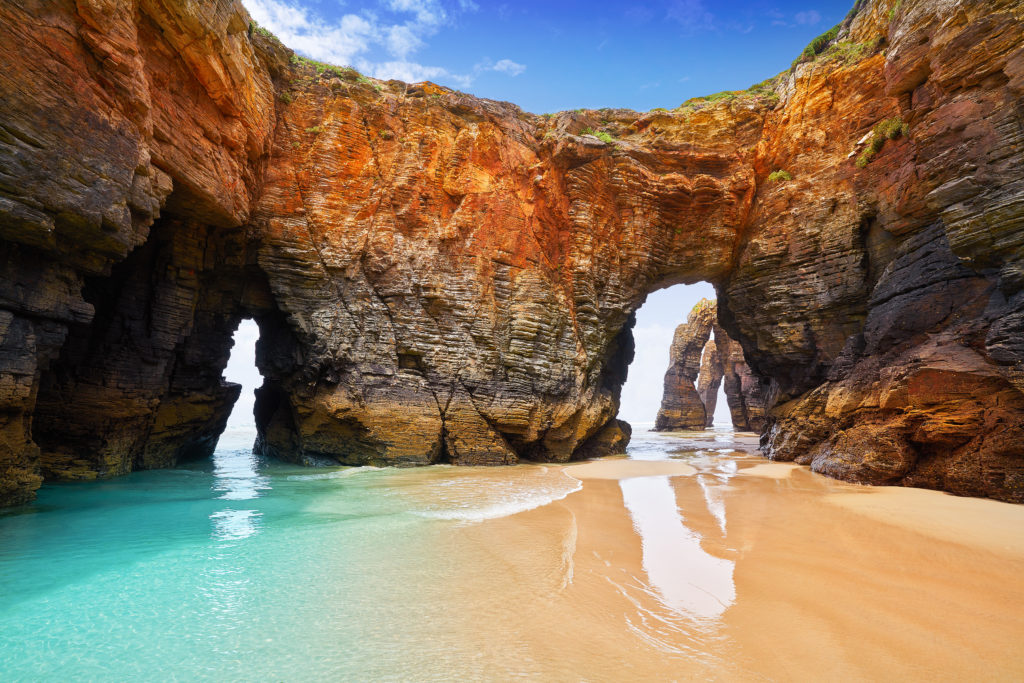
Slow down and get off the main roads. Oviedo, the capital of Asturias, is a possible stopping place for the night. The Fine Arts Museum of Asturias looks intriguing.
Days 4 to 5: Llanes and the Picos de Europa
You’ll encounter rugged mountain vistas as you continue east toward the Picos de Europa. The jagged peaks of Picos de Europa National Park, Spain’s first national park, are nicknamed “Spain’s Dolomites.”
The mountains straddle southeast Asturias, southwest Cantabria, and northern Castilla y León. If you’re a hiker, you’ll want to spend a few days here.
One option is to home-base in the charming coastal town of Llanes (pronounced YAH-ness).
We discovered Llanes by accident on our drive across northern Spain. For once, I hadn’t booked a hotel, deciding that we’d just stop driving when we got tired and hope for the best. I don’t recommend that approach, particularly in the busy summer months, but sometimes it’s fun to live dangerously!
I saw the sign for Llanes, figured it was as good a place as any, and directed Gregg to the old town.
What a fortuitous decision! The little seaside town of Llanes turned out to be delightful, with beautiful buildings covered in fine woodwork and small windows. An inland waterway lined on both sides with cafés runs through the town center. Pull up a chair in one of the cafés to enjoy some tapas and beer, and watch the boats go by.
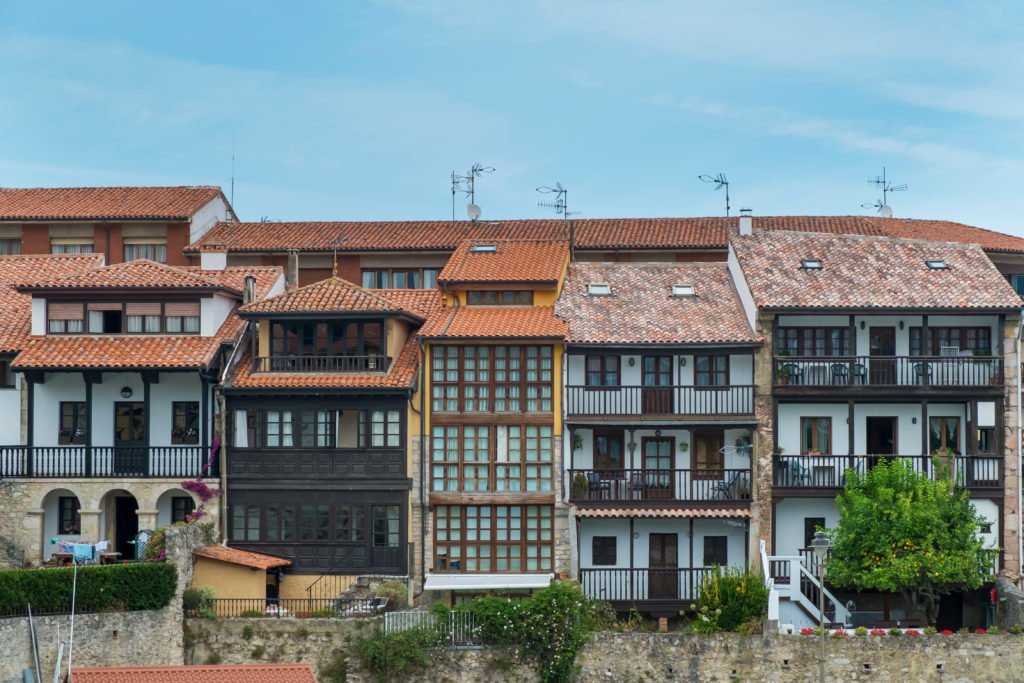
Take a walk out to the breakwater. An artist has painted the huge concrete blocks that protect the town from high tides with all sorts of crazy patterns.
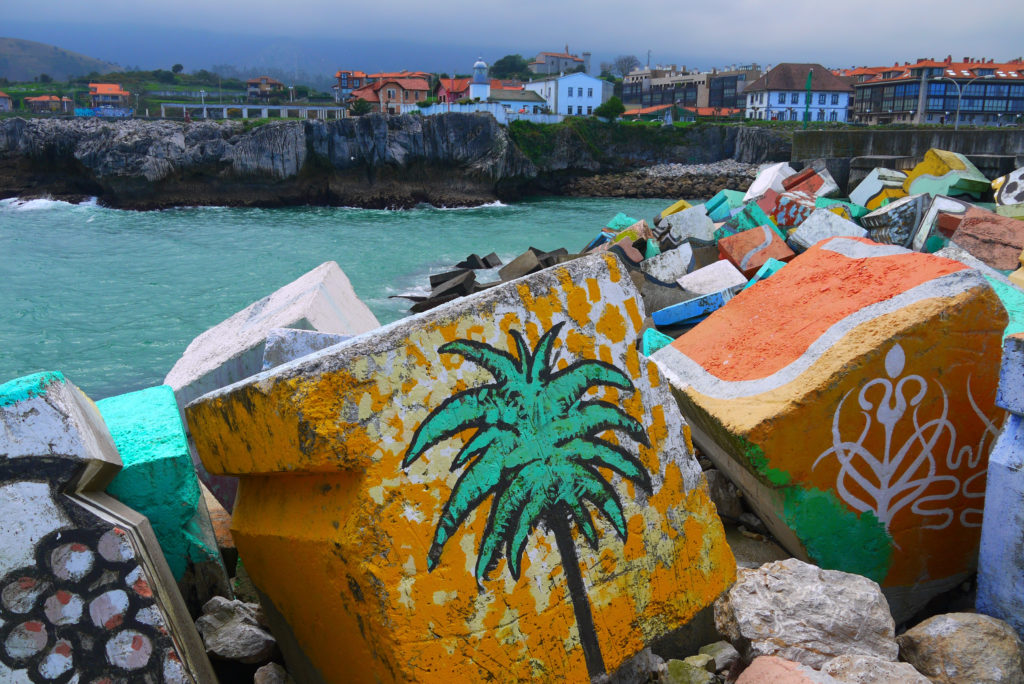
Watch the sun set over the Atlantic and prepare to be enchanted.
Eat dinner at an outdoor café in the network of tiny lanes in the old town. Two three-course meals and several glasses of red wine cost us just €10. Now, that’s a bargain!
The waiter insisted on giving us several of his cards so we could tell everyone we met about his restaurant. We wandered back through picturesque squares to our hotel, situated in a renovated convent.
In the middle of the night, I woke up, terrified that something—someone—was in the room. Perhaps a nun, long dead, was not happy to find me sleeping in a room that had once been her cell. I was so frightened that I had to wake up Gregg!
Is it likely that thousands of years of history—much of it violent—has produced its share of discontented ghosts?
Maybe.
Day 6: Santillana del Mar
The Caves of Altamira are located close to Santillana del Mar. Alas, we haven’t visited them yet, prehistory buffs though we are.
For information about the caves and what to see in beautiful Santillana del Mar, click here.
Bilbao
The drive from Santillana del Mar along the coast to Bilbao is gorgeous. Get off the highway and explore some of the windswept, rock-choked coves. This part of northern Spain is spectacular.
Bilbao is a large port city with a tangle of highways leading to the Nervión River and the Guggenheim. Use your GPS to navigate into the city, and avoid hotels in the old town. We chose the Hotel Melià, a modern hotel on the river, which was easy to find and included a large parking garage.
The street signs written in the Euskara language are daunting and largely unpronounceable, at least for foreign tourists like us! Many of the streets have names consisting of 20 letters, most of which are X’s and Z’s. When you’re in Basque country, you may forget you’re still in Spain.
Fortunately, you’ll easily get by in Spanish and English.
The big attraction in Bilbao is the Guggenheim Museum, one of the world’s top modern art museums. I love that the city of Bilbao decided to revitalize itself and attract tourist euros by building a world-class art museum. That choice showed vision along with a heartening belief in the importance of art and culture.
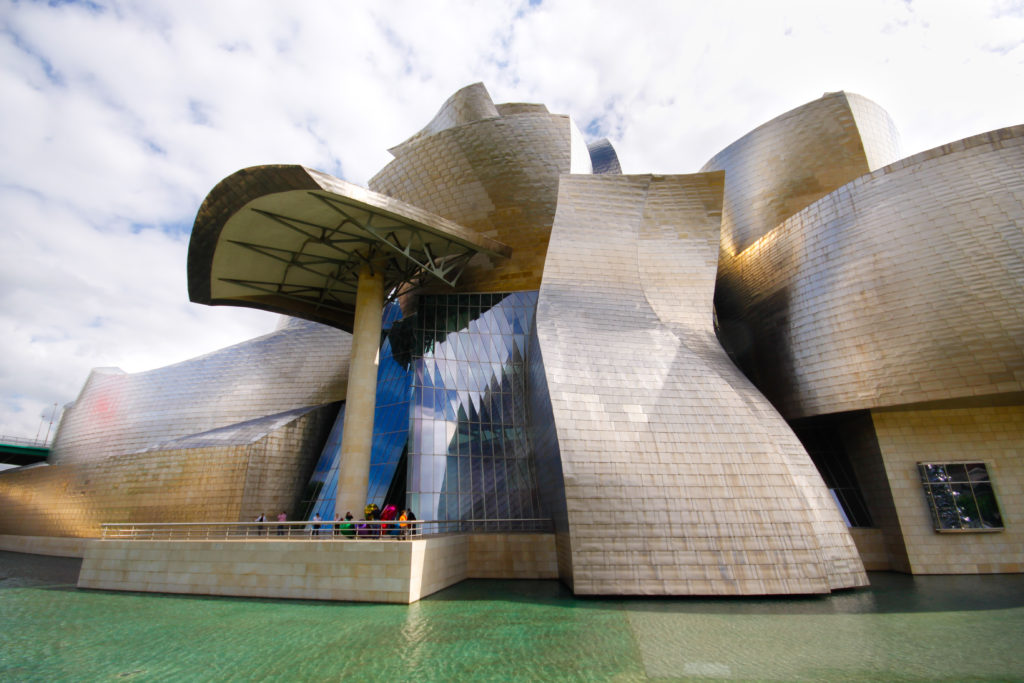
We chose one of the ultra-modern hotels in an ultra-modern area of Bilbao about a ten-minute stroll along the river from the Guggenheim. Read my suggestions for hotels in Bilbao in Where to Stay in Spain: My Best Picks.
Likely your first view of the Guggenheim will be of Puppy, the colossal topiary of a West Highland White Terrier that stands guard in front of the museum. With its variegated coat of flowers that changes with the season, Puppy is remarkably photogenic.
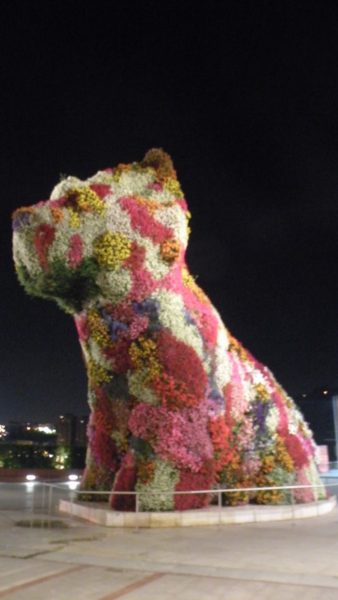
After you’ve satiated your thirst for Puppy pics, walk around the building to admire the silvery-gold slabs of hammered, stamped steel of Frank Gehry’s Guggenheim and to view more of the modern sculptures.
You’ll see Anish Kapoor’s astonishing sculpture of huge silver orbs stacked almost as high as the roof of the museum and facing the river. The piece is perfectly situated to catch the sun, turning the entire column of orbs into one pulsing, glistening beacon. Another marvelous sculpture is Maman by Louise Bourgeois—a massive spider and not recommended for arachnophobes.
Once you’ve had your fill of the exterior, enter the Guggenheim and get your bearings. See what the special exhibition is, study the maps or download the app, and plan your route.
A highlight is the enormous sculpture by Richard Serra on the ground floor. The work consists of six steel slabs bent and curled in various ways that invite you into their depths to wander until you feel dizzy. We went into two of the sculptures, and that was enough! The effect is startling, and a little goes a long way.
When we visited, we saw a stylishly curated exhibition of new paintings and digital works by David Hockney.
Following your visit to the Guggenheim, stroll across the bridge to the old town to spend your evening enjoying tapas and drinks. On your way back, you’ll see the Guggenheim and Puppy evocatively floodlit.
San Sebastian
If you’re driving to San Sebastian—called Donostia by the Basques—your first view may be nondescript suburbs miles away from the famous sweep of beach. Persevere until you reach the water and the old town.
Our hotel was situated at the top of Mount Urgull, one of two mountains that flank San Sebastian. Here’s the stunning view of San Sebastian from near our hotel.
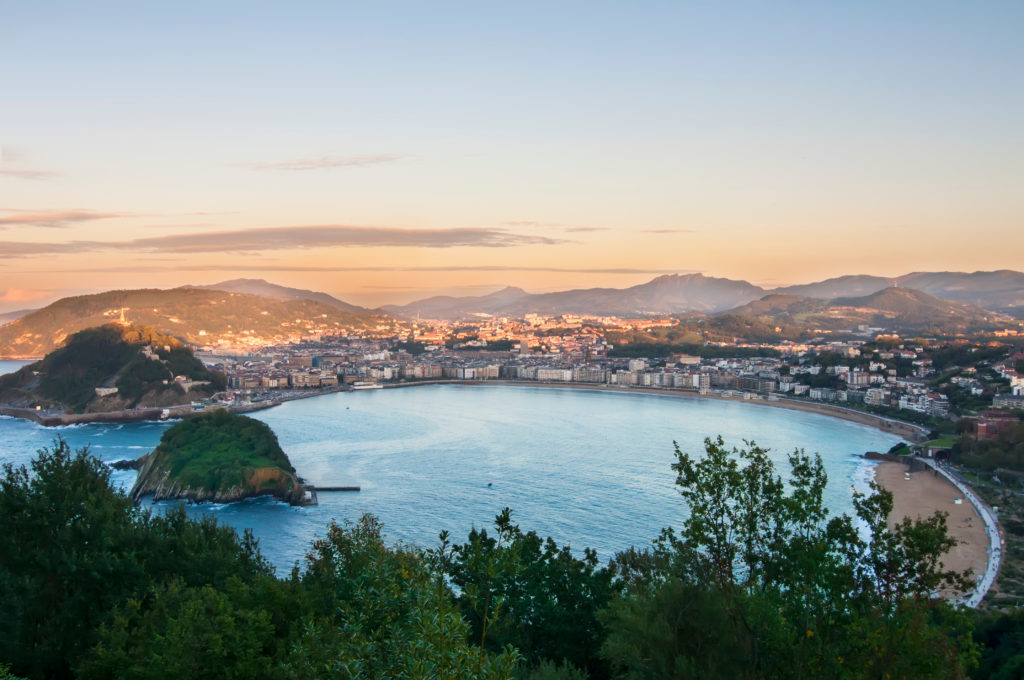
Traffic in San Sebastian was remarkably sedate when we were there. Head for one of the big parking lots in the commercial center and then explore San Sebastian on foot.
San Sebastian consists of three main areas – the long sweep of beach bristling with frolicking holiday-makers, the modern town built on an easy-to-navigate grid system, and the old town with its narrow streets and intriguing aromas.
Spend your evening in San Sebastian bar-hopping in the old town to sample as many pinchos (pintxos) as possible.
Squeeze into a bar (they’re all crowded!), grab a plate, select a few cold pinchos from the platters lined up on the bar (so many varieties to choose from!), grab a glass of local wine, eat standing up amid the crowds, then saunter off to another place.
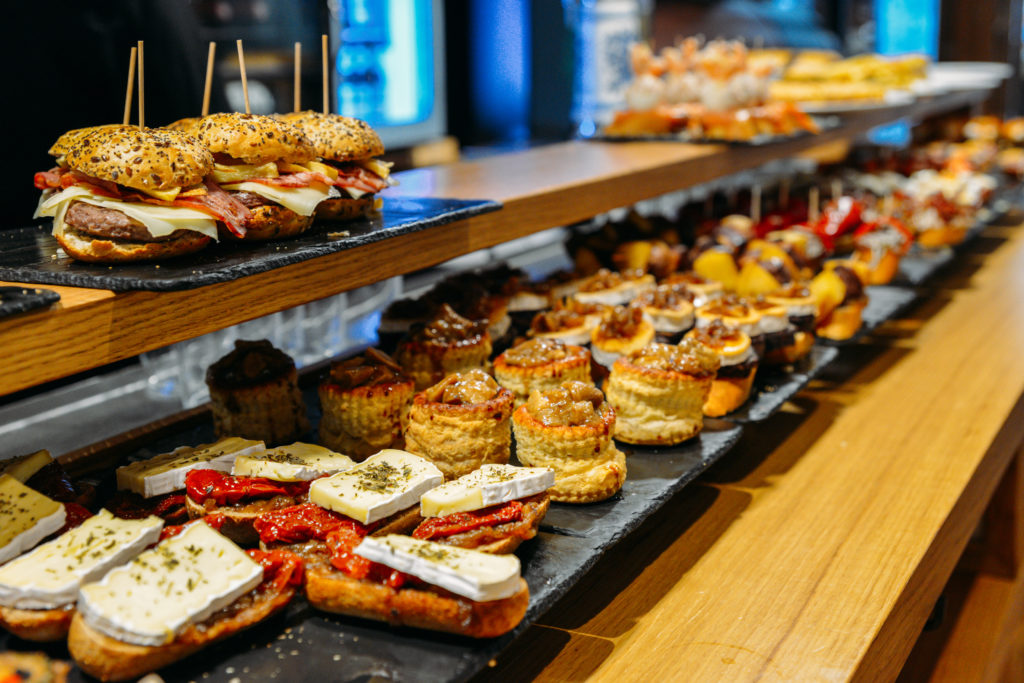
Each pincho is a mini work of art. If you don’t see something you like on the cold platters, order hot pinchos listed on chalkboards behind the bar.
The incredibly efficient servers keep track of what you’ve eaten by the number of toothpicks left on your plate. You also crumple up your used napkins and throw them on the floor—a practice that takes some getting used to!
Go from bar to bar sampling two or three pinchos at each, along with a glass of wine. Prices are amazingly reasonable. Our evening of pincho-eating and wine-guzzling cost just €30, including two gelatos.
Everyone seemed in great humor. Families with little kids filled the streets late into the evening. The San Sebastian people know how to live!
Where to Stay in Northern Spain
For accommodation suggestions in Santiago de Compostela, Llanes, San Sebastian, and Bilbao, see Where to Stay in Spain: My Best Picks.
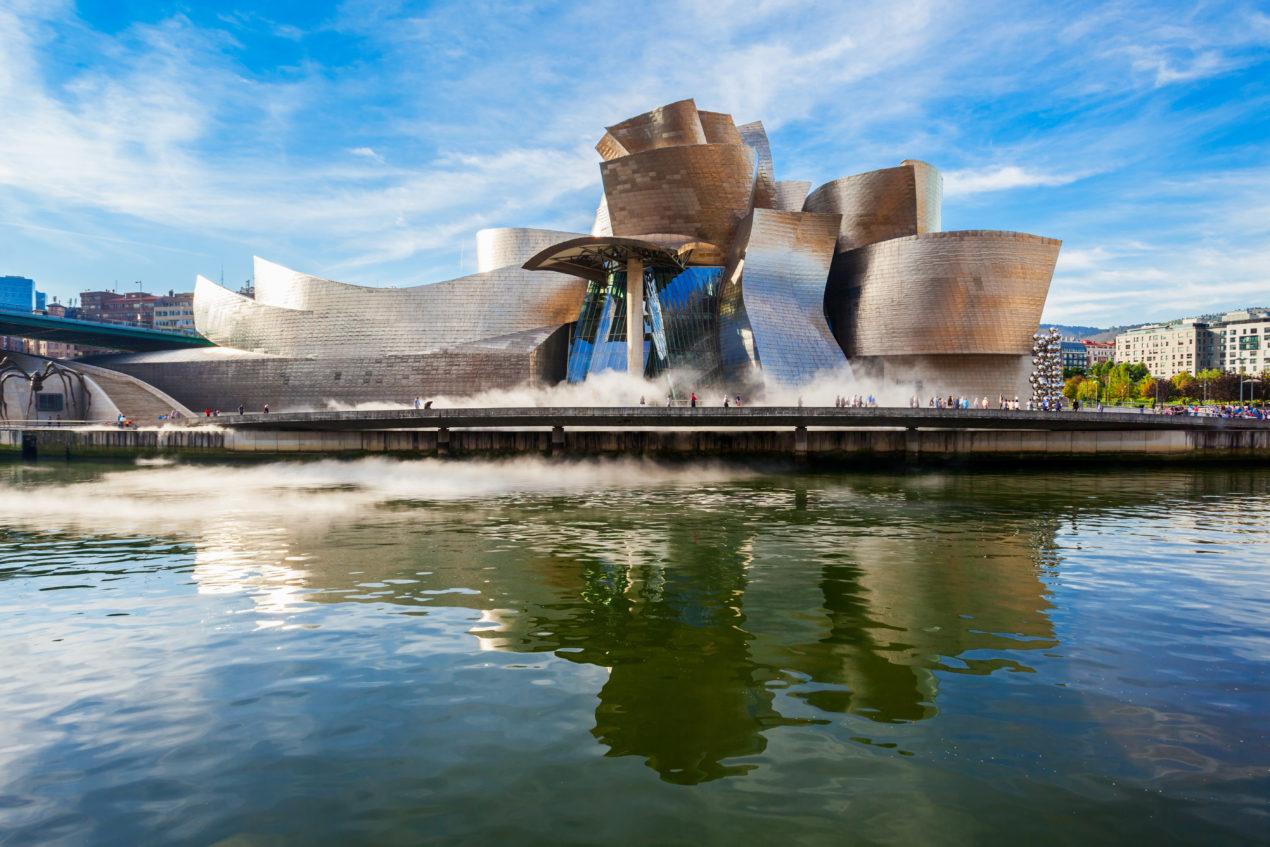
[…] Santiago de Compostela: Exploring Northern Spain & Basque Country […]